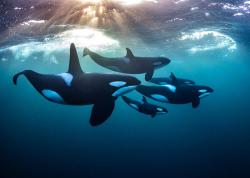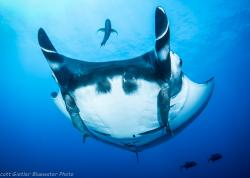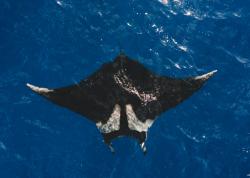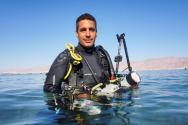Diving Cebu, Philippines
The Philippines is a must on every diver’s bucket list, especially underwater photographers. There are many reasons for this, but above all is the outstanding diversity of marine life to dive with.
This is why I selected Cebu, Philippines, as the destination to conduct one of my underwater photography workshops last February. I knew for a fact the area would provide my students with a diverse, rich, and interesting photography experience.
The workshop included 14 members of varying experience in underwater photography. The diving itinerary included dive sites known to provide the best underwater photography opportunities – including Negros, Apo, Sumilon, Malapascua, and Gato.
See also: Best Diving in the Philippines: Top 8 Locations

My Photo System of Choice
My photo system of choice was the Sony a6500 mirrorless camera accommodated inside a Fantasea FA6500 Housing and a variety of Fantasea FML ports. Strobe lighting was supplied by a dual Ikelite DS-160 strobe system.
My macro setup included the Sony 90mm f/2.8 macro lens, a lens capable of producing great super macro shots even without a wet lens, as well as a dedicated focus gear, which proved to be very useful since manual focus was often essential in order to capture the perfect the image. I was also equipped with the Fantasea AOI UCL-09F +12.5 super macro wet lens for extra magnification when shooting tiny subjects.
My wide-angle lens was the Canon 8-15mm f/4 L fisheye lens.
In order to avoid focus hunting in low light conditions, especially in dark sand dive sites, I used the Fantasea Radiant 3000F Light. To scan the area in search for small subjects, I selected the powerful narrow beam, and then switched to a red light whenever attempting to focus on the subject. The Radiant’s 120 degree wide beam mode also served me well for capturing videos, both macro and wide.
I installed the Fantasea UMG-02 LCD Magnifier on my housing for an enlarged, clear view of the camera screen. This proved to be especially useful in macro dives, as I was capable of better identifying the details and focus points on the screen. Furthermore, I mostly aim to shoot subjects from “eye level” and since small species are often found on the sand in this area. The tilted UMG-02 LCD Magnifier is very helpful when shooting from a low level in an upwards angle.
Negros Island
Upon landing in Cebu, we headed south to Negros Island and arrived at the Atlantis Dumaguete resort, which is situated at the beach of Dauin on the Southeast coast of Negros. This is the perfect area to start a diving holiday. Most of the dives around the resort are carried out in sheltered bays, providing easy and comfortable diving conditions. It’s also an excellent macro photography destination.

Dauin is dived at easy entry sites that offer a varied selection of small marine animals rather than large reefs. When diving from shore, you’re most likely to notice many signs on the road indicating where the nearest dive beach is. At every site where diving is allowed, there is a ranger who monitors diving activities, making sure that there is no fishing and that the environment is well protected. A small fee is collected from divers visiting these dive sites. When diving here, you’ll encounter quite a few artificial reefs established by the local dive operations. My personal recommendation would be to focus on the great macro opportunities this area has to offer.
The sand at Negros is very dark and serves as an appealing background for underwater images. It is important to take into consideration that most of the special marine life is found scattered along the sand patches rather than on top of the reef.
Among the photogenic marine species that can be found at Dauin are a huge variety of nudibranchs, ghost pipefish, anemone crabs, mantis shrimps, blue ring octopuses, and my favorite – flamboyant cuttlefish.
Finding the Right “Critter Spotter”
During each dive, we separated to groups of 2-4 divers, to avoid overcrowding and fin impacts. We aimed to remain in the same general area to benefit from exchanging information with each other whenever finding anything unique.
The key for a good dive at Dauin is finding a good “critter spotter” capable of finding the very best photo subjects the area has to offer. Some of the local dive guides are known for being such good spotters that they’re booked months ahead by divers who book their services in advance. Once you’ve got your hands on an experienced critter spotter it’s important to follow a few guidelines to get the most out of your time with them. First and foremost, make sure to master your diving skills. The less your guide must deal with your buoyancy, equalizing difficulties, and any other diving difficulties, the more they will be able to focus on searching and finding exactly what you came for!
Second, make sure to inform your dive guide ahead of the dive which subjects you’re most interested in finding and photographing. There’s nothing more annoying than having to leave a rare tiny shrimp you’ve almost perfectly captured just to find out that the guide was so eager to show you a sea turtle…more so if you were geared with a super macro lens!
It can even be a good idea to familiarize your guide with your photo gear. This is especially true for the lens options you have, so that they have a better understanding of the size of subjects you’re looking for and the distance you’re capable of shooting them from.
Finally, once you’ve nailed a shot of a subject they’ve found for you, don't forget to share your sense of success with them and thank them for a job well done. Rightfully rewarding a guide for their efforts is a great way get them excited before the next dive. Some of my spotters even asked me for those images we’ve captured together and shared them with their colleagues and friends with great pride!
The Art of Diving with a Group
When diving in a group, the challenge is to capture the images you want without being overrun and overwhelmed by the other divers. Naturally, whenever a good subject is found, every photographer wants to shoot it. Because everyone shares the same objective, it’s important to plan for the best solution for the group. For example, while one photographer is shooting a subject, others can shoot it at the same time from a different distance and angle. Alternatively, while one photographer is occupied with the subject, others can take advantage of the opportunity to look for different interesting subjects nearby. This is probably a better way of utilizing your time rather than hanging around and exerting pressure on the photographer, reducing the chances that anyone ends up with satisfying images. If you’ve found an additional point of interest, it will also surely motivate the photographer to finish shooting quicker and move on to the next spot...
Camera Settings for Negros Island
Since there’s so much to shoot on each dive, one does not want to run out of battery power during the dive. This is especially true in Negros. It’s important to reduce battery consumption as replacing batteries on a small boat or on shore during the breaks between dives is far from ideal.
First, shooting with a higher ISO will allow less strobe power for each shot and reduce the chance of having to replace batteries after each dive. It will, however lower the quality of the photo and add noise to the image. Another way to avoid battery drain is to consider canceling the auto review of images on the screen and browse through images only when needed. Turn off your camera when searching for the next subject and only turn it back on when it's your turn to capture images. While waiting for your turn to capture a special subject, try setting up your frame on a nearby object so you’re ready when you reach the main attraction.
Photographing Nudis
When photographing a Nudibranch, make sure that the focus point is set either on its front two rhinophores or on the exposed gills on its back. If photographing the Nudibranch from its front, try positioning your lens within a straight 90-degree angle so the front of the Nudibranch is focused and the rest of its body gradually blurs out. Another option is shooting them from the side, thus having more details of their body in focus. Whatever you do, avoid shooting them from the top. Take into consideration that some of the nudibranch species here are extremely small, such as the sheep nudibranch. The first time I was shooting one, I had no clue what I was looking at and only figured it out when reviewing the image on the camera screen and zooming in. I was more prepared for the next shot, that’s for sure…
Apo Island
After diving in Dauin, it is a good idea to visit a small nearby island – Apo. The cruise to Apo Island takes less than an hour on the local Banca boat, a great experience in itself. Apo Island is more exposed to currents, making the diving here quite different from the diving in Dauin. The reef is pretty healthy and offers some good wide angle photo opportunities. On top of that, the strong currents make macro photography more difficult when trying to focus on small marine species. All the more reason to get equipped for a wide-angle dive!
Apo Island offers a very nice reef with a wall that drops from about 10 to 50 meters (33-165 ft). The wall is very much alive and packed with corals. On Apo, you will find quite a few Banded Sea Kraits (sea snakes) swimming up and down along the wall. The sea snakes must surface in order to breath so try following them on their way down to the reef, increasing the chances one will stick around for a while. If you stay out of its way, it will scan the reef right next to you in search for pray, providing you with plenty of great photo opportunities. Try capturing the lovely reef in the background of the snake, perhaps with a nice sun ball on top. Other interesting subjects include groups of Razor Fish and underwater bubbles that appear as a result of volcanic activity. Apo Island is also a very good place to meet sea turtles, rays, frogfish and a variety of small critters, such as crabs and nudibranchs.
Whale Sharks in Oslob
The next stop on our trip was the Whale Shark site at Oslob, Cebu Island. Oslob is a small fishing village that became very famous due to the Whale Shark program that has been conducted here for the last 10 years or so. According to the stories, up until 20 years ago, the local fisherman of Oslob used to fish Whale Sharks. Once Whale Shark fishing was outlawed, in order to avoid accidently catching Whale Sharks in their nets, the fishermen began attracting them away from the fishing grounds by throwing krill to the water. This led to a situation in which Whale Sharks often frequent the Oslob Bay area in order to feed on the krill. Naturally, as soon as the rumor spread out, many tourists began arriving each day to swim and scuba dive with the largest fish in the world. Today the program is being run by the government. They now supervise the activity, tag, and document the Whale Sharks that visit the spot, and monitor how this affects their habits and migration.
As soon as the boat arrived at the site, a few Whale Sharks started swimming up to the boat, circling us and then swimming back to the small feeding Banca boat.
The Whale Shark program dictates a few regulations that need to be followed. Divers must be accompanied by a licensed instructor. It is forbidden to use any artificial lights, such as strobes or video lights. Divers must keep a distance of at least 1 meter (3 ft.) from the Whale Shark and feeding Banca boat.
Unlike the dark volcanic sand of Negros, the bottom here is composed of bright white sand that can be easily stirred up. The maximum depth is 10 meters (33 feet) with very poor visibility close to the bottom, but clarity close to the surface. The Whale Sharks don’t mind the divers at all. Most of the time they are busy taking turns feeding on the krill thrown to the water from the boats. In my opinion, it's amazing to see such a beautiful, huge yet gentle critter swimming next to you. However, the whole experience feels unnatural and lacks the surprise of running into a Whale Shark while swimming or diving in open water. After about half an hour, I found most of the divers on my group circling a small reef on the bottom or heading back to the boat.
As for photo tips, I strongly suggest using the widest lens possible here and shooting in shallow water for better light and visibility. At some point, try to get a split shot of the Whale Shark and the island in the background. I used the burst mode and spent a while working on this frame, leaving me with quite a few images to delete later…
It’s also a good idea to set the shutter speed above 1/250 to avoid motion blur as you’ll be shooting without a strobe.
My personal point of view on the Oslob experience is that although we are interfering with nature and feeding Whale Sharks is a bad habit, it's still much better than what used to happen here. It was only 20 years ago when these gentle giants were slaughtered and sold. If we ask the locals to protect the marine life, we should probably support other ways for them to make a living. The sooner the locals figure out that they can benefit from the well being of marine animals, the sooner they will be motivated to protect them. I hope one day this will include an end to whale shark feeding!
See also: Top 6 Whale Shark Diving Locations

Sumilon Island
Sumilon Island is about 30 minutes away from Oslob. It's a great diving destination with a beautiful reef and a good place to meet some pelagic marine animals coming in from the deep. We had two dives on both the Eastern and Western sides of the island. The highlights were a huge number and variety of sea anemones and clown fish, as well as large schools of fish that came in from deep water, close to the reef.
Here I used the Canon 8-15mm fisheye lens – especially for CFWA (Close Focus Wide Angle) shots of abundant corals formation and the colorful anemones. At one point, a Blacktip Reef Shark passed by, but it was too far for our wide-angle lenses.
As we were gearing up for the second dive, we noticed a huge dark blotch coming towards us in the water. We began guessing what it is – a whale shark? A school of mackerel? Upon entering the water, it turned out to be a very large school of jacks that circled us for a few minutes, allowing us to photograph them from every possible angle.
Malapascua
After a nice visit to the waterfalls and the warm natural volcanic lakes of Cebu, we headed up north for a new adventure at the island of Malapascua. We had three objectives in mind: to dive with the magnificent Thresher sharks, to meet the most beautiful fish in the sea – the mandarin fish, and to find the 'holy grail' of the Philippines – the pigmy seahorse!
When traveling from Negros to Malapascua, dedicate a full day for the trip. This includes a drive up to Dumaguete pier, a ferry ride to Cebu, and crossing the island from south to north. This is followed by another ferry to the small island Malapascua. Trust me, it’s worth it! For my group of divers, this was, by far, the best part of the trip.
Thresher Sharks at Monad Shoal
After checking into the dive center, we setup our equipment and prepared ourselves for an early morning wake-up. At 04:45 am, a group of half-awake divers gathered for a short briefing, followed by an hour-long boat ride out to Monad Shoal to watch the sunrise from below the surface. The reason for such an early wake up (and there should be a good one when you’re on holiday!) was to make it on time to meet the rare thresher sharks that often visit Monad Shoal around sunrise.
Monad Shoal is an underwater mountain rising to about 26 meters (85 feet) at its summit. It’s best to dive here with Nitrox to allow for a longer bottom time and a higher chance of meeting the sharks. We were very lucky and were visited by two sharks coming up to a cleaning station, with a third one swimming at a distance not far behind!
This is one hell of a photographic challenge. Strobes are not permitted when shooting the sharks. Considering the depth and lack of ambient light at this early time of the day, it is quite dark. Based on this, I chose to shoot only videos on this dive.
Gato Island
After successfully meeting our main goal for the day, we boarded for two dives at Gato island. It turned out to be one of the best dive sites we’ve visited so far! During the dives we spotted frog fish, seahorses, white tip reef sharks, a very shy cat shark, loads of crabs, shrimps, nudibranchs and moray eels – all of which was spread over a beautiful and colorful reef complete with a cavern that allows a swim through from one side of the island to the other!
The Search for Pygmy Seahorses
The next goal was to find a Pigmy Seahorse. Following advice we got from the Evolution dive center, we headed out for a dive at Deep Slope, where we easily found a pigmy seahorse. The seahorse was too small for most of the photographers to get a decent picture of it, except those equipped with a good macro lens and great eyesight!
Gear
To capture a worthy image of the Pigmy Seahorse, you must first have great macro capabilities, meaning a quality macro lens. I used my Sony 90mm macro lens together with the Fantasea AOI UCL-09F +12.5 super macro wet lens for extra magnification. If using a focus light, it’s a good idea to use a red color beam to avoid scaring off the Seahorse.
Angles
There are several angles you can use to shoot the Seahorse. If shooting parallel to the sea fan, you can get a nice side view image. However, if you’re lucky enough to have the sea horse seated towards the edge of the sea fan, you can capture it from an upfront angle.
Finding a Focal Point
To find the seahorse on your screen so you can focus on it, try mentally marking some unique elements next to the seahorse that can be found when looking through the camera screen. If that doesn’t help, focus on the sea fan, shoot, and hope for the best! To increase your chances of having it focused in the frame, it’s best to position yourself as parallel as possible to the sea fan and to use a small aperture, keeping as many elements as possible in focus.
Upon leaving the seahorse, we also encountered some frogfish, mantis shrimp, and a school of striped eel catfish.
The World’s Most Beautiful Fish
I decided to dedicate the last dive of the trip to the chance of witnessing mandarin fish mate. Every evening, during the very last moments of day light, mandarin fish tend to gather in search of a mating partner. We were determined to be there to see it …
We descended as the sun was setting at the best mandarin site of the island. When we spotted a mandarin fish near a few table corals, we circled around the coral head in anticipation for the show. We used only red light and the fish didn't seem to mind as the courting dance began. For almost an hour, a male mandarin fish and two females were attempting to impress each other in a series of fast movements. At some point, two of these fish began swimming together out of the corals and eventually mated in front of our eyes. It was an amazing sight and all of us divers were screaming in happiness when the much anticipated moment finally arrived!

Conclusions
Diving in the Cebu area is a wonderful value-for-money experience for advanced photographers who wish to expand and upgrade their photo archives. Marine life and seascapes around this area are diverse, unique, and interesting. There are many opportunities to polish your photography skills in a controlled environment featuring both macro and wide-angle subjects. No doubt I’ll be back in these waters for another photography workshop soon!
Book Your Trip to the Philippines

View availability of some of the best liveaboards in the Philippines
RECOMMENDED ARTICLES
SUPPORT THE UNDERWATER PHOTOGRAPHY GUIDE:
The Best Service & Prices on u/w Photo Gear
 Visit Bluewater Photo & Video for all your underwater photography and video gear. Click, or call the team at (310) 633-5052 for expert advice!
Visit Bluewater Photo & Video for all your underwater photography and video gear. Click, or call the team at (310) 633-5052 for expert advice!
The Best Pricing, Service & Expert Advice to Book your Dive Trips
 Bluewater Travel is your full-service scuba travel agency. Let our expert advisers plan and book your next dive vacation. Run by divers, for divers.
Bluewater Travel is your full-service scuba travel agency. Let our expert advisers plan and book your next dive vacation. Run by divers, for divers.




















































